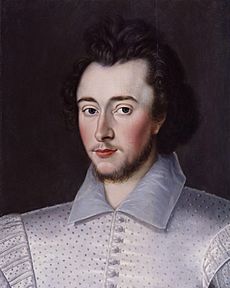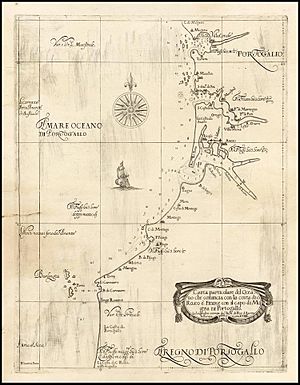Robert Dudley (explorer) facts for kids
Quick facts for kids
Robert Dudley
|
|
|---|---|
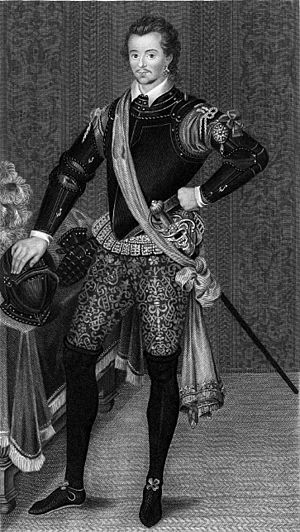
|
|
| Born | 7 August 1574 Richmond Palace, Surrey, England
|
| Died | 6 September 1649 (aged 75) Villa Rinieri, Grand Duchy of Tuscany
|
| Resting place | San Pancrazio, Florence |
| Known for | Courtier, explorer, cartographer, shipbuilder, engineer |
|
Notable work
|
Dell'Arcano del Mare |
| Spouse(s) | Margaret Cavendish Alice Leigh Elizabeth Southwell |
| Children |
|
| Parent(s) | Robert Dudley, 1st Earl of Leicester Lady Douglas Sheffield née Howard |
Sir Robert Dudley (born August 7, 1574 – died September 6, 1649) was an English explorer and mapmaker. In 1594, he led a trip to the West Indies, writing about his adventures. He was the son of Robert Dudley, 1st Earl of Leicester, and inherited much of his father's property, including Kenilworth Castle. From 1603 to 1605, he tried to prove he was legally his father's son in court, but he was not successful. After this, he left England for good. He found a new life working for the grand dukes of Tuscany in Italy. There, he worked as an engineer and built ships. He also created and published Dell'Arcano del Mare (1645-1646), which was the first sea atlas to show the entire world. He was also a very good navigator and mathematician. In Italy, he called himself "Earl of Warwick and Leicester" and "Duke of Northumberland." This last title was recognized by Emperor Ferdinand II.
Contents
Early Life and Family
Robert Dudley was the son of Robert Dudley, 1st Earl of Leicester and Douglas Sheffield. Douglas was the daughter of William Howard, 1st Baron Howard of Effingham. Robert grew up in his father's homes and with his father's friends. He could visit his mother whenever she wanted. His mother married Sir Edward Stafford in November 1579 and then moved to Paris.
Robert's father, the Earl of Leicester, cared deeply for his son. He often traveled to see him. Robert received an excellent education. In 1587, he joined Christ Church, Oxford, as an "Earl's son." His teacher there was Thomas Chaloner, who also became a close friend.
In 1588, when the Spanish Armada threatened England, 14-year-old Robert joined his father. His father was leading the army at Tilbury Camp, ready to fight a Spanish invasion. But on September 4, his father died. In his will, Robert received a large inheritance. This included Kenilworth Castle and its lands. When his uncle, Ambrose Dudley, 3rd Earl of Warwick, died, Robert also inherited lands in Denbigh and Chirk.
In early 1591, Robert was supposed to marry Frances Vavasour. Queen Elizabeth I liked Robert very much and agreed to the marriage. However, she wanted him to wait until he was older. Later that year, Frances secretly married another man and was sent away from court. Then, 17-year-old Robert married Margaret, who was the sister of Sir Thomas Cavendish. Robert had likely invested money in Sir Thomas's last sea journey. Robert was kept away from court for a few days because of this secret marriage. Margaret received two ships from her father, named the Leicester and the Roebuck. She died soon after, without having any children.
Robert Dudley's Expeditions
In 1594, Dudley put together a group of ships. These included his main ship, the galleon Beare, along with the Beare's Whelpe, and two smaller ships called pinnaces, the Earwig and the Frisking. He planned to use these ships to attack Spanish vessels in the Atlantic Ocean. Queen Elizabeth did not approve of his plan. She thought he was too inexperienced and that the ships were too valuable. However, she did make him a general. She insisted he sail to Guiana instead.
Dudley hired 275 experienced sailors. These included the navigator Abraham Kendal and captains Thomas Jobson and Benjamin Wood. Dudley's fleet set sail on November 6, 1594. But a sudden storm separated the ships and forced them back to different ports. Dudley sent a message to the captain of the Beare's Whelp to meet him in the Canary Islands or Cabo Blanco. Then, he sailed again.
At first, Dudley's trip was not very lucky. The Earwig sank, and most of the ships he found were friendly. Dudley only led one attack in the Gulf of Lagos.
In December, the expedition finally captured two Spanish ships near Tenerife. Dudley renamed them Intent and Regard. He put his own sailors on them and put Captain Woods in charge. He sailed to Cabo Blanco, hoping to meet the Beare's Whelp there, but it did not appear. Dudley's fleet sailed to Trinidad and stopped at Cedros Bay on January 31, 1595. There, he found an island and claimed it for England, naming it Dudleiana. Then he sailed to Paracoa Bay for repairs. He also explored San Jose de Oruna but decided not to attack it.
Dudley split his forces, sending the Intent and Regard north. In Trinidad, he hired a Spanish-speaking Indian. This guide promised to lead an expedition to a gold mine up the Orinoco River. The expedition, led by Captain Jobson, returned after two weeks. It turned out their guide had left them, and they had struggled to get back. Dudley then returned to Trinidad.
On March 12, Dudley's fleet sailed north. There, they finally captured a Spanish merchant ship. They then sailed to Cabo Rojo, in Puerto Rico. They waited for a good target for some time, then sailed towards Bermuda. A storm pushed the Beare north, near what is now New England. The fleet finally reached the Azores. With low supplies and working guns, Dudley sailed for home. But he met a Spanish man-of-war on the way. He managed to outsmart and damage it in a two-day battle. However, he decided not to board it. The Beare arrived at St Ives in Cornwall at the end of May 1595. Dudley heard that Captain Woods had captured three ships.
The next year, 1596, Dudley joined Robert Devereux, 2nd Earl of Essex. He served as commander of the Nonpareil in an expedition against Cadiz. He was later made a knight for his actions in the Capture of Cadiz. What he did exactly is not written down. Soon after, he married Alice, who was the daughter of Sir Thomas Leigh of Stoneleigh.
In 1597, Dudley sent Captain Wood on a trading trip to China. He sent the Beare, the Beare's Whelp, and the Benjamin. However, these ships never returned.
Claiming His Birthright
In May 1603, Robert Dudley said that a man named Thomas Drury told him his parents had been secretly married. He then began trying to claim the titles of Earl of Leicester and Earl of Warwick. He also wanted the property of his deceased uncle Ambrose Dudley, including Warwick Castle.
The case went to the Star Chamber court in 1604–1605. It attracted a lot of public attention. Ninety witnesses spoke for Dudley, and 57 spoke for the widowed Countess of Leicester, Lettice Knollys. Dudley convinced his mother to support his claim. She stated in writing that his father had promised to marry her in Cannon Row, Westminster, in 1571. She also said they were married at Esher, Surrey, "in wintertime" in 1573. However, all 10 people she named as witnesses to the ceremony had already died. She also could not remember who the "minister" was or the exact date of the marriage.
The Star Chamber court rejected this evidence. They also fined several of the witnesses. The court decided that Sir Robert Dudley had been tricked by Drury, who was seeking "his own private gains." King James I agreed with this decision, and it was announced on May 10, 1605. In 1621, an official investigation in Tuscany, Dudley's new country, also looked into the matter. It concluded that Dudley's "friends maintain that his father married Lady Sheffield, but they are unable to account for her marriage during his lifetime, an act so injurious to the alleged legitimacy of her son."
Life in Italy
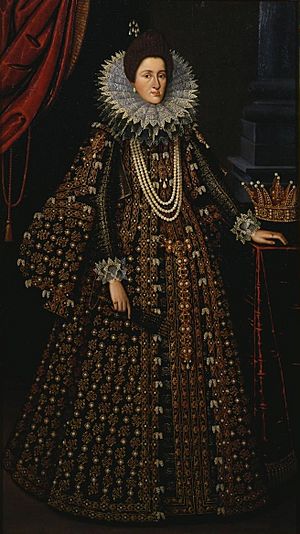
Dudley left England in July 1605, traveling through Calais. His relative and partner, Elizabeth Southwell, went with him. She was disguised as a page. Elizabeth was the daughter of Sir Robert Southwell and Lady Elizabeth Howard. Lady Elizabeth was a granddaughter of Charles Howard, 1st Earl of Nottingham, who was Dudley's uncle. The couple announced that they had become Catholic.
Dudley married Elizabeth Southwell in Lyon in 1606. They received special permission from the Pope because they were blood relatives. They first settled in Florence. Under English law, this marriage was not valid because he was still married to Lady Alice. However, the Pope did not recognize his marriage to Alice, as it had taken place in the Church of England. Dudley began to use his father's title of Earl of Leicester and his uncle's title of Earl of Warwick.
Dudley designed and built warships for the Livorno arsenal. He became a naval advisor to Ferdinand I, Grand Duke of Tuscany, who was part of the Medici family. He received a yearly payment of 2,000 ducats. In 1608, Dudley convinced the Duke to send a privateer ship, the Santa Lucia Buonaventura, to Guiana and northern Brazil. This was the only attempt by Italians to colonize the Americas, known as the Thornton expedition.
Attempts to Return to England
King James I took away Dudley's permission to travel in 1607. When the King ordered Dudley to return home to care for his wife and family he had left behind, Dudley refused. He was then declared an outlaw, and his property was taken by the government.
He continued to communicate with the English court through Sir Thomas Chaloner. Chaloner was now a chamberlain to Henry, Prince of Wales. Dudley wrote to the young Prince about navigation and shipbuilding. In 1611, he tried to arrange a marriage between the Prince and Caterina, who was Duke Ferdinand's daughter.
Meanwhile, Prince Henry Frederick had grown fond of Kenilworth Castle. He called it "the most noble and magnificent thing in the midland parts of this realm." Wanting the castle, he agreed in 1611 to buy it from Dudley for £14,500. Dudley was to remain in charge of the castle for his lifetime. When Henry died in 1612, only £3,000 had been paid. It is not clear if Dudley ever received this money. The new Prince of Wales, Charles, then took possession of the castle but did not pay the rest of the money. In 1621, he passed a law allowing Dudley's wife to sell the estate to him for £4,000.
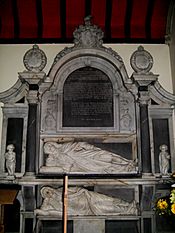
In 1618, King James I gave the titles of Earl of Leicester and Earl of Warwick to other people. These were Lord Lisle and Lord Rich. In 1620, Dudley convinced Grand Duchess Maria Magdalena, wife of the new duke Cosimo II, to ask her brother, Emperor Ferdinand II, to recognize his claim to his grandfather's title of Duke of Northumberland. Dudley succeeded on March 9, 1620. After this, King James I stopped all talks of reconciliation.
Later Years and Legacy
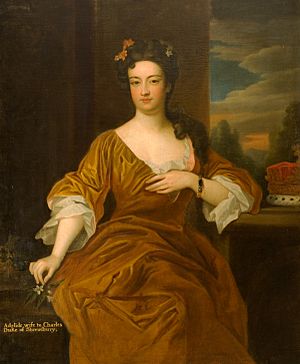
Besides building ships, Dudley worked on many projects in Tuscany. These included the Livorno's breakwater and harbor defenses. He also helped drain local swamps and built a palace in Florence. He designed new galleys, which were types of ships. Between 1610 and 1620, he wrote his memories about navigation and seamanship.
Later, Dudley put his notes into six volumes of Dell'Arcano del Mare (The Secret of the Sea). He published this work himself in 1646–1647. He also wrote a Maritime Directory as a guide for the Tuscan Navy, but it was never published. In 1631, his wife Elizabeth died the day after giving birth to her last child. Several of their 13 children married into Italian noble families.
In 1644, King Charles I made Dudley's second wife, Alice, Duchess of Dudley for life. The King also recognized Dudley's legal birth, but he did not give back his titles or property. Robert Dudley died on September 6, 1649, outside Florence in Villa Rinieri (now Villa Corsini a Castello). He was buried at San Pancrazio in Florence.
One of Dudley's sons was Carlo Dudley, who was called Duke of Northumberland. Carlo was the father of Maria Cristina Dudley. She was the second wife of Marquis Andrea Paleotti. They were the parents of Adelhida Paleotti, who married Charles Talbot, 1st Duke of Shrewsbury. They did not have any children. Even though Dudley's descendants married into noble families, "No Dudleys in the male line now remained to carry on the name. After the third generation they became extinct in Italy."
In 1660, after the monarchy was restored in England, Lady Alice, Dudley's second wife, asked King Charles II to recognize her title as Duchess of Northumberland. She also asked for her daughters, Lady Katherine Leveson and Lady Anne Holborne, to have the same rank as a duchess's daughters. However, the King kept the title for himself. He gave it instead to his son, George Fitzroy.
Dudley left his property to Ferdinando II de' Medici, Grand Duke of Tuscany. His collection of scientific tools is on display at the Museo Galileo (Galileo Museum) in Florence.
Dell'Arcano del Mare
The most important of Dudley's works was Dell'Arcano del Mare (Secrets of the Sea). It includes a full guide on navigation and shipbuilding. It is famous for being the first atlas of sea charts for the whole world. Dell'Arcano del Mare has six known volumes. They show Dudley's knowledge of navigation, shipbuilding, and astronomy. It includes 130 original maps. These maps were all his own creations and not copied from other maps, which was unusual for that time. It was first published in Florence in 1645 in Italian. This work collected all the naval knowledge of that time. The atlas also suggests building a fleet of five different sizes of ships, which Dudley had designed and described. Dell'Arcano del Mare was printed again in Florence in 1661, but without the maps from the first edition. A special feature of Dudley's maps was that they were an early use of the Mercator projection.


